Sometimes baking requires improvising. If something doesn’t work out the way you’ve planned, don’t bin it … pivot!
Most of the bakers in the Great White Tent improvised a bit with their Dobos tortes. Nancy Birtwhistle, in particular, had problems with her chocolate ganache and had to remake it at least twice. Nevertheless, she persisted.
“Once something goes wrong, like my ganache went wrong,” she said in this episode, “it’s all about keeping your head on.”
I learned some lessons about keeping my head on while making my Coffee and Walnut Dobos Torte, as well. First, I ran out of coffee buttercream, with barely enough to fill the first tier. But because I had already made praline powder to decorate the outside, I whipped up a batch of praline buttercream for the second tier. Later, when decorating the torte, it became clear that my caramel drip wasn’t working, so I used more of the praline powder and some chopped walnuts to decorate my bottom tier instead.
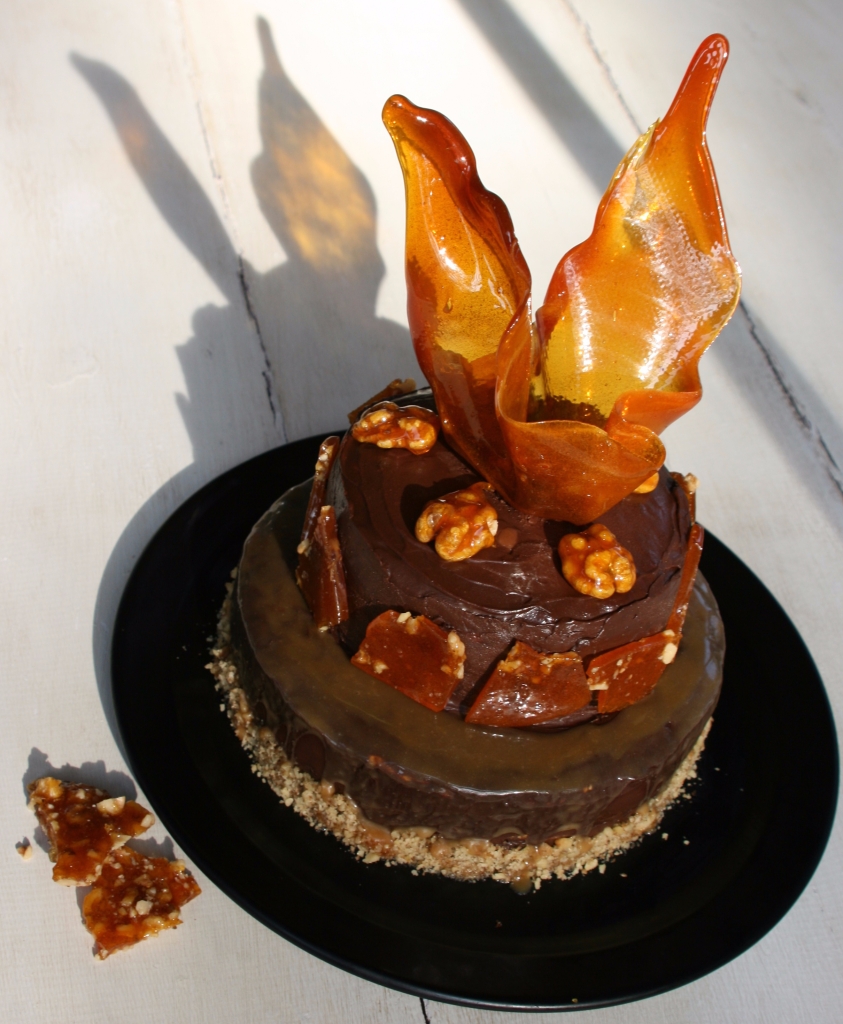
Dobos torte, an invention of Hungarian confectioner Jozsef C. Dobos in 1884, is generally made with one tier consisting of five to seven thin layers of sponge cake filled with chocolate buttercream and topped with a brittle shell of hardened caramel. The brief for this Bake-Off challenge, however, was for a modern version featuring at least two tiers with an “emphasis on caramel and sugar work.” In addition, Mary Berry was looking for an even sponge-to-filling ratio.
When researching my bakes, I like to look up similar recipes from some of the Bake-Off contestants to see how they made their creations. Oddly enough, for this bake, I couldn’t find a single one—only Mary Berry’s own Dobos torte recipe. On a whim, I sent a Facebook message to Nancy Birtwhistle to ask if she had made a Dobos torte since her time on Bake Off, hoping she had published her recipe elsewhere. To my surprise, she messaged back: “No – it gave me nightmares”!
With that as a warning, I embarked on this challenge with a bit more trepidation.
Choosing as my inspiration the classic British coffee-and-walnut cake, I adapted this recipe of another Hungarian layered dessert, the Dios torte. It is made with a fatless sponge in which finely chopped walnuts replace most of the flour. Similar to making a Dobos torte, egg whites are whipped to stiff peak stage and folded in at the end to make a light batter that’s stable enough to hold its shape while baking. That’s important because, rather than baking the cake in one pan and slicing it horizontally into multiple layers (a no-no for an authentic Dobos torte), the batter is spread onto parchment paper outlined with the desired size and shape and baked in thin layers about ¼-inch thick. In this case, I made six 8-inch layers and six 6-inch layers for my two round tiers.
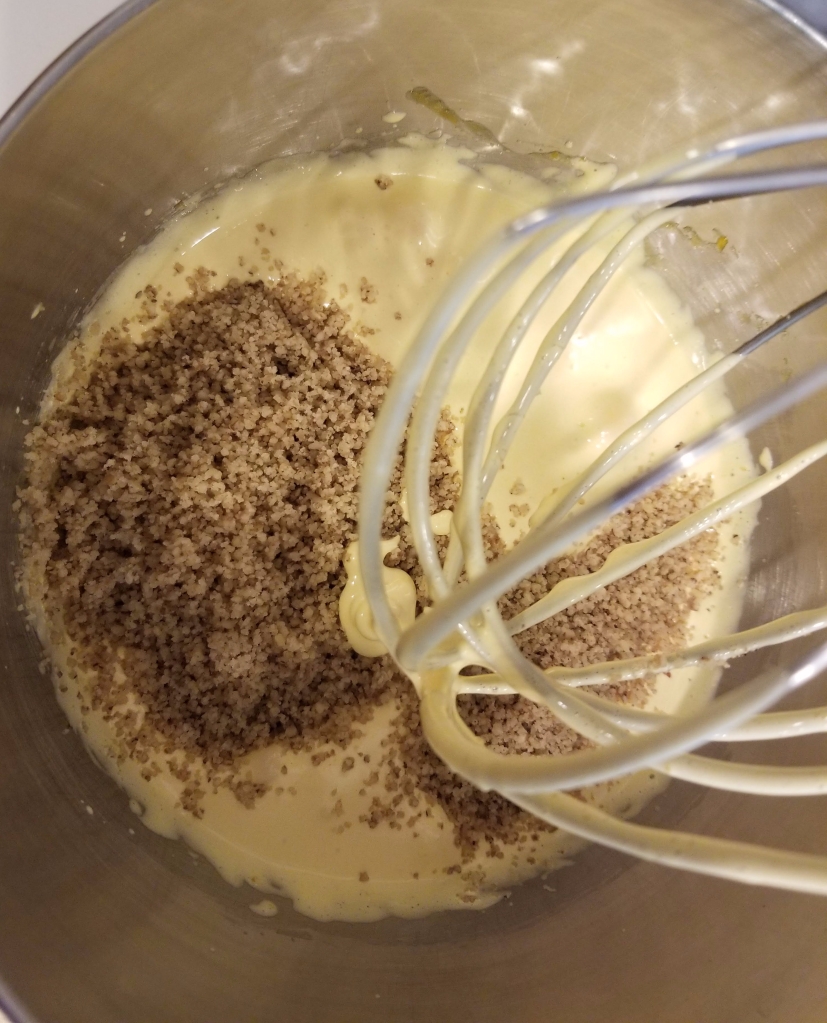
Ground walnuts take the place of most of the flour. 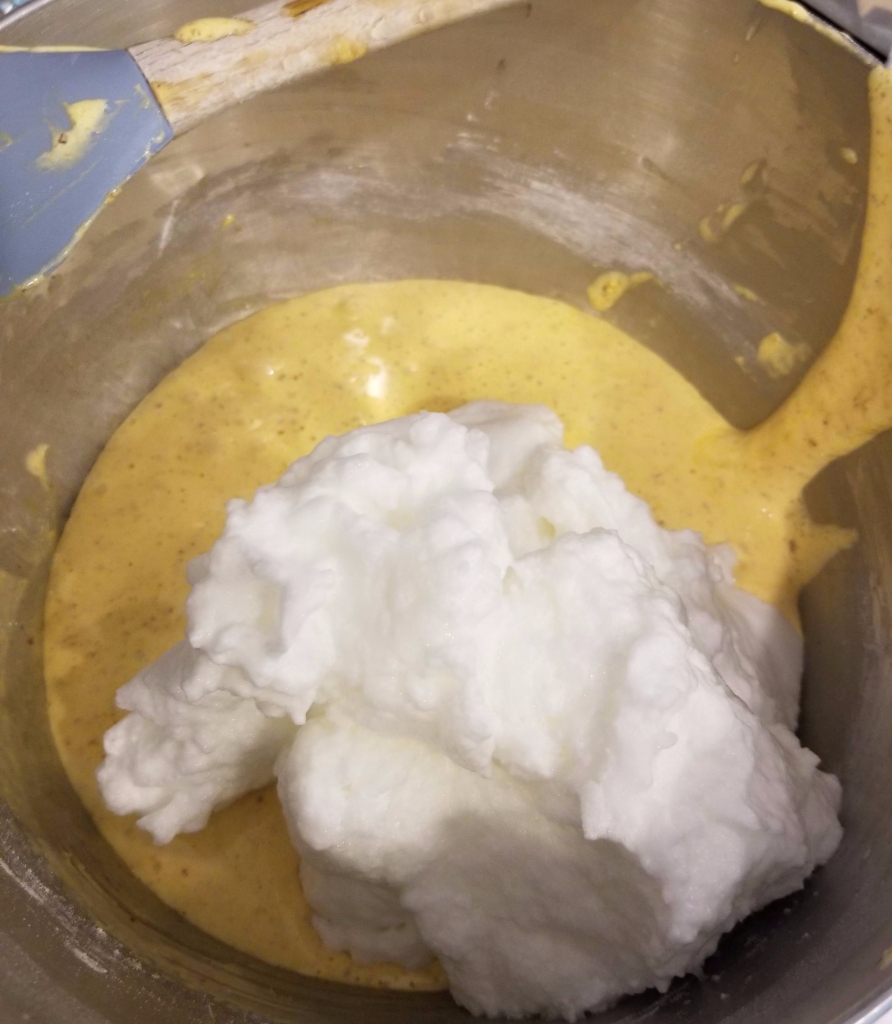
Whipped egg whites add air and stability to the batter… 
Which keeps the batter from spreading while it’s baked.
While somewhat tedious, making the 12 layers was not that difficult. Each layer only bakes for seven to 10 minutes, so it goes pretty quickly and can be done in assembly-line fashion: three baking sheets at a time with one or two layers on each, in and out of the oven in less than 10 minutes, and then the next batch goes in.
The more difficult part, in my opinion, was making the caramel decorations for the cake. Remember, the judges wanted to see caramel and sugar work, something I’ve had difficulty with in the past. In order to make this a true showstopper, I decided to make candied walnuts, praline shards and praline powder as well as a caramel sugar sail, something I’ve been seeing a lot of on social media lately, so I was excited to try it. Initially, I also wanted to apply a caramel drip to one of the tiers, but in the end, it didn’t stand out against the chocolate ganache coating and didn’t firm up enough — it kept pooling at the bottom of the cake. (I have subsequently omitted it from my recipe, but if you want to try it, I recommend the recipe here with the accompanying how-to video.) Still, that means I made caramel three times for this bake!
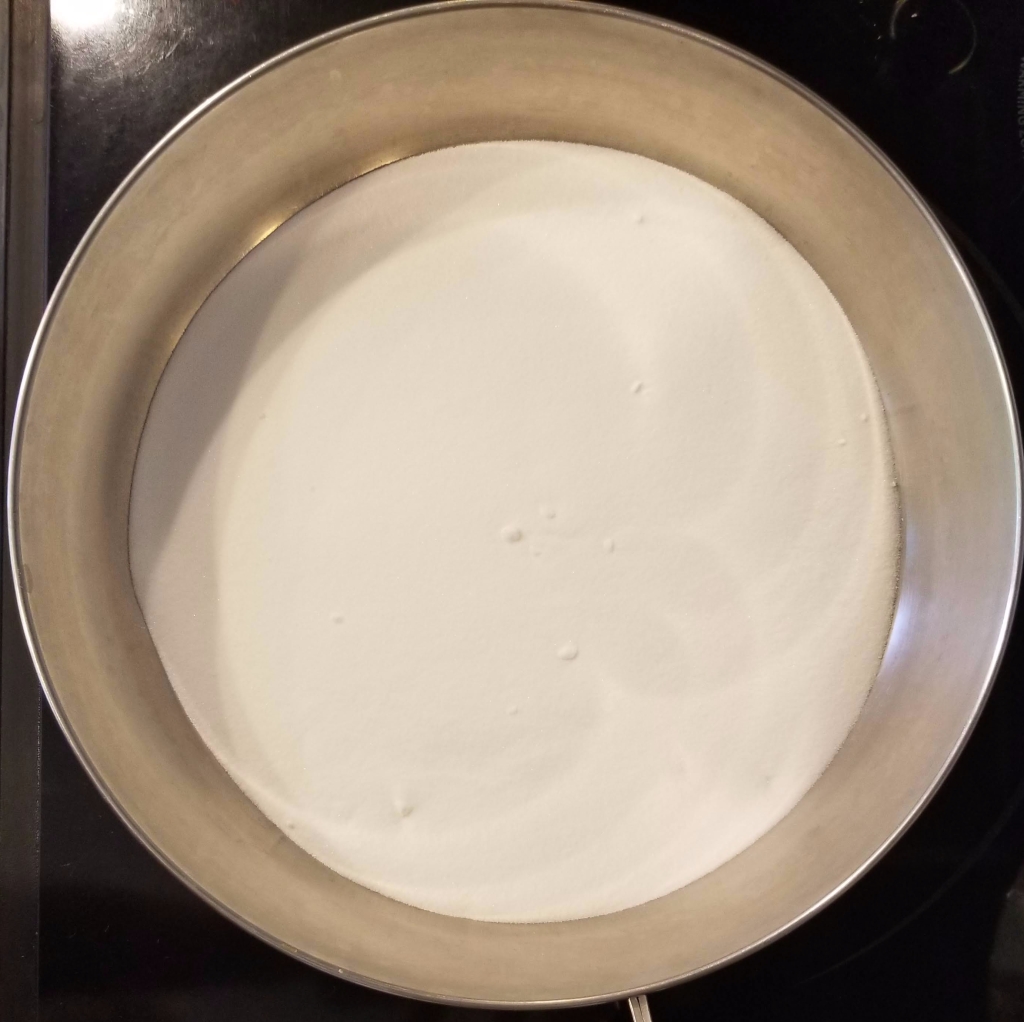
For the dry method, don’t stir until sugar starts to melt. 
Once it starts to melt, you can stir. Don’t worry if lumps form. 
Keep stirring and you will get a beautiful golden caramel!
As I have written before, making caramel with the dry method works best for me, because I don’t have to worry about it crystallizing. I do have to worry about it burning, but that has been less of a problem for me. So I made my first batch of caramel using that method and poured some of it over chopped walnuts for the praline, using the rest to dip some walnut halves in for my candied walnuts. After the praline hardened, I ground some of it into a fine powder and reserved the rest to make shards for the outside of the torte.
Once the praline was done and my cake layers were baked and cooling, I began working on the fillings. I chose a favorite of mine, coffee crème au beurre (French buttercream), which I’ve used here and here. But I realized halfway through assembling the first tier that I wouldn’t have enough for the second tier. Scrambling, I quickly found this recipe for praline buttercream, using some of the powdered praline I had already made. (Thank you, Martha Stewart!) In hindsight, I would use the praline buttercream for the larger, bottom tier and the coffee buttercream for the smaller, top tier so I could spread it a little thicker. (I have made that adjustment in the recipe below.)
After assembling my tiers, I popped them in the freezer while I whipped up some chocolate ganache to cover them with. I used my go-to ganache recipe, which you can find here. While the ganache was firming up, I took the tiers out of the freezer and trimmed the sides so they were even, then I spread them with the ganache.
The final step before decorating the torte was to make the caramel sail. I used the same technique for making caramel with the dry method, and once the sugar was melted and a deep amber color, I poured it onto a silicone mat. I let the syrup thicken a bit before lifting the mat and placing it over a bottle. (This is the trickiest part because you don’t want the melted sugar to drip onto your hands.) To create “waves” in the sail, I clipped the folds of the silicone mat together, below the syrup, and left it to harden for about 20 minutes. For a helpful video, check out this one on Hanielas.com.

After pressing the praline powder and praline shards into the sides of the torte, I placed the candied walnuts and the sail on top. Voila! It not only looked like a showstopper, it tasted like one! The sponge was moist and light, the fillings sweet and buttery, and the ganache and caramel rounded out a rich flavor profile that would give any Hungarian pastry shop a run for its money.
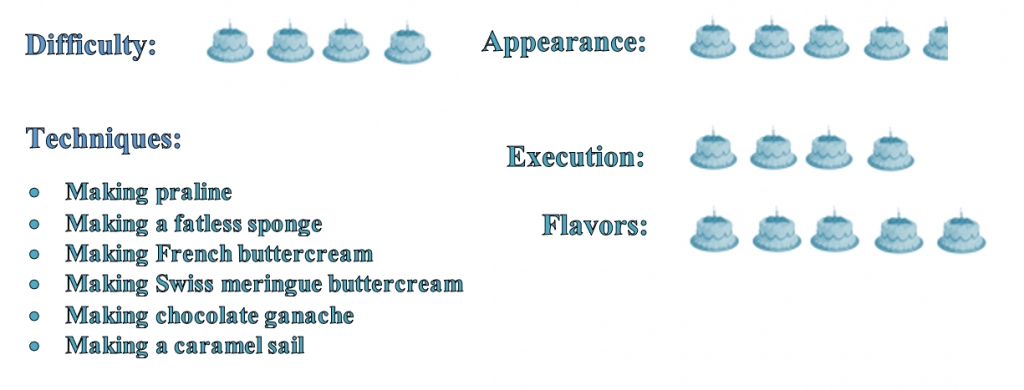

Coffee and Walnut Dobos Torte
Coffee buttercream recipe adapted from LittleFrenchBakery.com
Praline buttercream recipe adapted from MarthaStewart.com
Credit for ganache: PrettySimpleSweet.com
Recipe for caramel sail adapted from Hanielas.com
For praline:
- 8 walnut halves
- 1 c. coarsely chopped walnuts
- 2 c. granulated sugar
For sponge layers:
- 12 large eggs, separated
- 3/4 c. sugar
- 1 c. finely ground walnuts
- 4 T. cake flour
- 1 T. baking powder
- Zest of 1 lemon
For coffee buttercream:
- ¼ lb. (scant 2 c.) instant espresso or coffee crystals
- 7 oz. (¾c. + 2 T.) water
- 1 3/8 c. sugar, divided
- 5 egg yolks
- 1 T. liquid (brandy is recommended, but coffee or even water will do)
- ¾ t. vanilla extract
- ¼ t. kosher salt
- 1 c. (2 sticks) unsalted butter, softened to room temperature (about 65°F)
For praline buttercream:
- 4 large egg whites (pasteurized preferred)
- 1/2 c. sugar
- 1 c. (2 sticks) unsalted butter, room temperature, cut into small pieces
- 1 1/4 c. praline powder (from praline recipe, above)
For ganache:
- 8 oz. semisweet or bittersweet chocolate, chopped (if using chips, increase chocolate by 1 tablespoon — about ½ ounce)
- 1 c. heavy cream
For caramel sail:
- 1 c. granulated sugar
Directions
- Start by making the praline. Spear the walnut halves with skewers. Spread chopped nuts on a parchment-lined baking sheet in a single layer. In a heavy saucepan, cook sugar over moderate heat without stirring until it begins to melt. Increase the heat and cook, stirring or swirling contents in pan until it’s completely melted and a golden caramel color.
- Remove pan from heat and immediately pour three-fourths of the melted sugar over the chopped walnuts. Tip the pan to spread the caramel, or flatten it using a greased palette knife. Dip the walnut halves in the remaining caramel, and stick the skewers into a piece of Styrofoam to cool. (Be careful not to let the hot caramel drip onto your fingers!)
- Cool completely, about 20 minutes. Then carefully break hardened caramel into shards. Place the larger shards in an airtight container between sheets of wax paper and store at room temperature until ready to decorate cake. To make praline powder, break the smaller shards into pieces and transfer to a food processor. Pulse until finely ground. (Store ground praline in an airtight container at cool room temperature. If it clumps, regrind it in food processor before using.) Reserve 1¼ cups of powder for the praline buttercream.
- For the sponge, preheat oven to 375°F. Mark six 8-inch circles and six 6-inch circles on baking parchment. Cut around each circle, leaving enough margin outside the circle for the batter to spread slightly. Flip the parchment over so the markings are on the underside, and butter and flour the circle on the reverse side. Shake off any excess flour, then lay the parchment circles on baking sheets. (Depending on the size of your baking sheets, you should be able to fit one or two circles on each.)
- In the bowl of an electric mixer fitted with a whisk attachment, beat egg yolks with sugar for 5 minutes or until light in color. Add nuts and mix thoroughly. Sift together flour and baking powder, and mix them into the batter until thoroughly incorporated. (If you only have one mixer bowl, transfer batter to another bowl and clean and dry both the bowl and the whisk attachment.)
- In a clean mixer bowl, beat egg whites on high with clean whisk attachment until stiff peaks form. Stir one-third of the egg whites into the batter to lighten it. Then gently fold in the remaining egg whites, trying not to deflate the volume. Fold in lemon zest.
- Use an offset spatula to spread batter evenly to about 1/4-inch thickness in each circle, spreading all the way to the edges. Bake for about 7-10 minutes until golden brown and sponge bounces back when touched lightly in center. Remove from oven and slide parchment paper to cooling rack. Transfer more batter-spread parchment circles to baking sheets and bake. (Sponges can be baked in batches, two or three baking sheets at a time.)
- When cool enough to handle, flip each sponge upside down and carefully peel parchment paper off the back, then flip sponge back over and leave to cool completely. When cooled, sponges can be stacked with parchment in between layers.
- To make the coffee buttercream, first make French coffee extract by dissolving the instant coffee in the water in a small saucepan and bringing it to a boil. In another saucepan, add 1 cup of sugar and heat it until the sugar melts and turns a dark amber color. (Yes, you are making caramel again!) When the syrup is the right color, slowly pour in the hot coffee. It will bubble and sputter, so be careful to protect your hands and fingers. Stir until all of the caramel dissolves. Cool and store in the refrigerator. (NOTE: I keep the extra coffee extract in my fridge so I don’t have to make it every time I make coffee buttercream. It would also be delicious in blended coffee drinks!)
- In a heatproof mixer bowl, combine egg yolks with 3/8 c. sugar, 1 tablespoon liquid, vanilla and salt. Whisk until completely blended together. Place the bowl on top of a saucepan containing about an inch of simmering water. (Make sure the bottom of the bowl does not touch the water). Stir and scrape the egg yolk mixture constantly with a flexible spatula until the mixture reaches 160°F. This should only take 5-6 minutes; if it seems to be taking too long, simply turn up the heat a little at a time.
- Transfer the bowl to a stand mixer fitted with a whisk attachment and whip at high speed until mixture is fluffy and stiff and beginning to ball up around the whisk — about 8 minutes. By this time, the bottom of the bowl should be cool to the touch.
- With the mixer still running, add butter 1-2 tablespoons at a time, waiting only a second or two between additions. This should result in a thick, creamy and spreadable texture. If the mixture seems to break apart, keep mixing; it will come back together.
- Add 1 tablespoon of the coffee extract and mix well. Taste to see if the coffee flavor is rich enough. If not, add another tablespoon or more, to taste. The buttercream should be a creamy coffee color with a nice coffee flavor. (Use buttercream right away, at room temperature, preferably between 68°F and 74°F. Leftover buttercream can be refrigerated for up to two weeks or frozen for up to two months. To reuse, bring to room temperature and rewhip before using.)
- To make the praline buttercream: In the heatproof bowl of an electric mixer set over a pan of simmering water, whisk together egg whites and sugar until mixture is warm to the touch and sugar has dissolved. (Note: If not using pasteurized egg whites, continue whisking over simmering water until egg mixture reaches 160F.)
- Transfer bowl to mixer fitted with the whisk attachment and beat on high until mixture is stiff and cool, about 5 minutes. Add butter all at once and beat until mixture has a smooth, spreadable consistency, about 5 more minutes. (Don’t worry if the buttercream separates and appears curdled; it will come back together with continued beating.)
- Add praline powder and beat to combine. (If using the same day, set aside, covered with plastic wrap, at room temperature, until ready to use. Or refrigerate in an airtight container up to three days. Before using, bring to room temperature; beat with paddle attachment until smooth.)
- To assemble the torte, place four strips of parchment or wax paper around the outer edges of your cake plate. Place first 8-inch cake layer on plate and spread praline buttercream on top and to edges with an offset spatula. Repeat with all layers, stacking cake as evenly as possible and keeping the thickness of the buttercream layers equal.) On another plate or a 6-inch cake board, do the same with the 6-inch layers using the coffee buttercream. Reserve any leftover buttercream to apply a crumb coat to the sides of the tiers later. Place both tiers in the freezer while you make the ganache.
- For the ganache, place chocolate in a medium heat-proof bowl and set aside. In a small saucepan over medium heat, bring the cream just to a boil. Remove from heat and immediately pour cream over chocolate and let it sit without stirring for 1-2 minutes, then whisk gently until chocolate is completely melted and mixture is smooth. Cool for 15 minutes to half an hour until thickened but still pourable.
- Remove tiers from freezer and use a long serrated knife to trim edges of sponge evenly. Using leftover buttercream, spread a thin coat on the sides of both tiers to keep the crumbs in.
- Pour a small amount of ganache on the top of each tier and spread to cover top. Spread more on the sides, smoothing as you go. When both sides are completely covered, transfer to fridge until ready to decorate.
- To make the caramel sail: Spread sugar evenly in the bottom of a heavy skillet. Heat on medium without stirring until sugar begins to melt. Stir until completely melted and syrup becomes a medium amber color. Remove pan from the heat and let caramel thicken to syrup consistency, then pour it onto a silicone mat. Let it begin to harden, but before it hardens completely, drape the mat over a tall bottle or inverted drinking glass. Use office clips or spring clamps to secure the folds in the mat below the syrup. (Be careful not to let the hot syrup drip on your hands!) Let caramel harden for 20 minutes, then remove clamps and clips and peel off the silicone.
- Store sail in an airtight container for up to 2 days. To keep it from absorbing moisture, place packets of silica desiccant or a small open container of rice in with it.
- Right before serving, remove tiers from fridge. Use a metal spatula to place smaller tier in the center of the larger tier. Use an offset spatula to apply powdered praline to the bottom edge of the bottom tier, then remove the paper strips from under the cake. Press praline shards into the sides of the top tier. Place caramel sail on top of the top tier and arrange candied walnuts around the outside edge. (If the sail is lopsided and wants to fall over, like mine did, place the candied walnuts strategically to support it.)



Marilyn, you did a great job. It looks like it was perfect. It looks yummy. Toya
LikeLike
Thanks, Toya! It was really yummy!
LikeLike